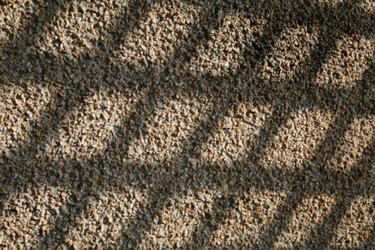
Pea gravel is just one type of material available for landscaping. When deciding which type of landscaping material to use, consider the look, price, installation process, availability and maintenance requirements. The cost of pea gravel is less expensive than many other types of construction materials. Installation is also easier than others. Pea gravel is considered semi-high maintenance, depending on the project it is used for.
Walkways: Pros
Video of the Day
Pea gravel used for a walkway provides a softer surface to walk on compared with using a larger type of gravel. Walking on pea gravel barefoot is more bearable than walking on larger rocks which some times have jagged edges that can stab at feet. Pea gravel is a common material found in historic locations and can be used to create a classic, timeless feel in a garden.
Video of the Day
Walkways: Cons
Smaller rocks in pea gravel can wedge themselves in the soles of shoes, and can be transferred into a home or other areas of the yard. Small children have a tendency to drag their feet or even kick the rocks out of the desired location.This is almost unavoidable, even if a border encloses the gravel. Pushing a wheel barrow or other items across the pea gravel walkway will create dips in the gravel that will need to be raked. Because the pea gravel has a smoother, rounder surface it does not compact. Simply walking on the path will lead to dips and require repeated raking to smooth the path.
Garden Beds: Pros
When pea gravel is used in place of mulch it can be quite useful to the plants in a garden bed. The pea gravel reflects heat far better than wood mulch, maintains moisture by trapping it beneath the rocks and limits weed growth.
Garden Beds: Cons
The small rocks will not stay in place without the assistance of a liner that is at least 1 inch taller than the height of the rocks. A buildup of pea gravel can eventually prevent perennials from growing through the rocks the following year. Only use a layer of pea gravel 2 inches thick in garden beds.
Fish Tanks: Pros
Dyed pea gravel is commonly used in fish tanks and in some ponds. Specific colors can match the decor of a room, or stand out completely on their own. This type of pea gravel is sold in pet stores and larger department stores.
Fish Tanks: Cons
The small size of the rocks allows them to be sucked into the pumping system and can cause damage to the pump. The rocks will require cleaning which involves removing and washing them on a regular basis to keep algae buildup to a minimum.
Driveways: Pros
Pea gravel can be used in two ways on a driveway. One is as a top coat over fresh gravel or concrete. When used in this manner, it has few cons. The pea gravel provides a textured surface to the concrete and prevents the surface from becoming slick when wet. It also transforms the traditional drab color of the concrete to a unique finish that can provide years of use with little to no maintenance. The other use for a pea gravel is to have the driveway made up of only pea gravel. The pro is the natural look it provides. The cons are the same as using pea gravel in walkways.